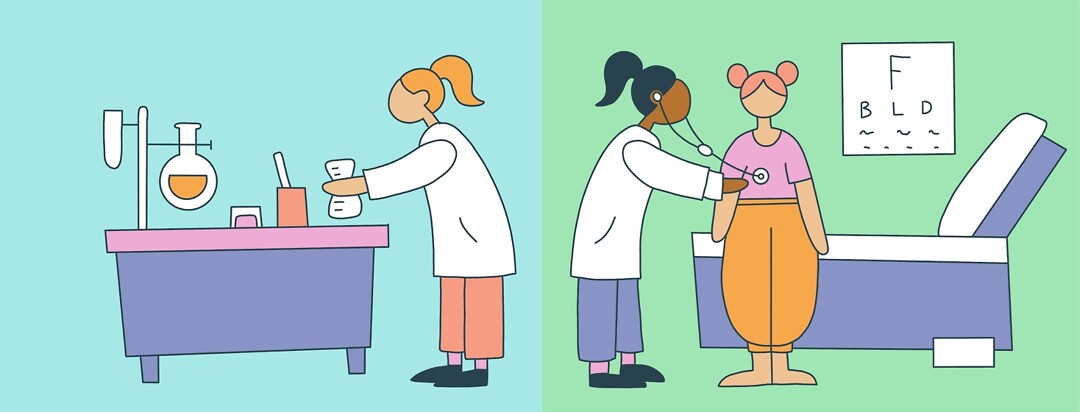Behind the Cancer Doctors
The survival of lung cancer patients depends on our doctors. Indeed, our doctors deserve every admiration from the patients. However, I would like to look further behind the doctors.
Research procedures
We first need to look at how cancer research is carried out. Cancer research consists of three parts: basic research, translational research, and clinical research. Basic research, also known as the "bench side” research, is conducted by scientists in the laboratory to study cancer cell lines and cell reaction to treatment. Translational research can be performed either by scientists or clinicians, and it applies discoveries in the lab to humans. Clinical research is mainly about clinical trials done by clinicians involving humans, which is also known as "bedside” research.
From now on, I avoid using doctors here because scientists, usually holding Ph.D. (Doctor of Philosophy) degrees, are called doctors at universities. Simultaneously, the clinicians are also called doctors with M.D. (Doctor of Medicine) degrees. So for every cancer treatment with a new drug developed in clinical trials, scientists are behind the clinicians. Here I specifically talk about oncologists.
Scientists and clinicians work as a team
I used to joke with my husband that scientists are brains and clinicians are the ears, eyes, and noses. Without the brain, everything stays idle. My husband counterattacked by saying that the eyes and ears go on strike to shut down everything, including the brain.
That is very true that clinicians and scientists rely on each other and must collaborate closely. Recently, I listened to Dr. Awad and Dr. Chiarle's talk at ALKtALK about cancer vaccines.1 They are both professors at Dana Farber Cancer Institute at Harvard University. Dr. Chiarle is a pathologist, and Dr. Wade is a clinician. They are an example of fruitful collaboration.
Dr. Chiaele developed the ideas to target ALK tumor cells with the lung cancer vaccine, but it was not a smooth sail to convince clinicians to come on board since targeted therapy was at its peak. The director of Thoracic Oncology at Harvard University suggested to Dr. Chiarle to move the idea of lung cancer vaccine forward, he needed a clinician to bring the idea to the clinic. The director gave Dr. Awad's name, and they started collaborating. After seven years of collaboration, the vaccine targeting ALK tumor is finally ready for the clinical trial later this year.
Few people can be both a scientist and a clinician
It's not easy for a person to be a clinician at the same time as a scientist. Some can be excellent clinicians, but not necessarily good researchers, and vice versa. The training and way of thinking are quite different.
Dr. Alice Shaw is of exceptional cases that she is an excellent clinician and a scientist. Dr. Shaw was a former Massachusetts General Hospital and Harvard University professor for 20 years. Starting last year, she is at Novartis Instate for BioMedical Research (Novartis) to head early drug development on oncology. In one of Dr. Shaw's talks, she detailed her journey from university to the drug company.2
Dr. Shaw said she found that the transition was a “huge” but “positive learning curve”. She said that being academics, you don't know anything about how to develop a drug. It was incredibly eye-opening. It made her think broadly about science, not restricted to ALK lung cancer, but different types of cancer. Dr. Shaw also said that it made her learn from other cancer types and applied them to ALK cancer. She also mentioned that to learn drug development, it's essential to do good basic science to inform clinical science to develop better drugs. Dr. Shaw said that it's tough to create a good drug.
This makes me think of a Chinese proverb that "a bird can only fly with both wings". Indeed, being academics is like a bird that has only one wing. Understanding how to make the drugs is like another wing. Indeed, Dr. Shaw is an "outstanding clinical trialist, physician, scientist, and collaborator".3
A Nobel laureate in chemistry invented the most well-known cancer drug
Dr. James Allison is an American prominent immunologist and Nobel laureate in 2018. He is a professor and the Chair of Immunology at the MD Anderson Cancer Center at the University of Texas. His research is in molecular immunology, and his discovery has led to new cancer treatments (immunotherapy) for prevalent cancers. We admire not only Dr. Allison for his scientific brilliance but also his ability to translate basic immunology into new cancer treatments - a rare ability to transfer the fundamental scientific work from the "bench side" to the "bedside".4
Chinese says that behind every man, there is always a good woman. When we admire the clinicians, don't forget there are always the scientists behind them.
Are you looking to discuss more with others?

Join the conversation